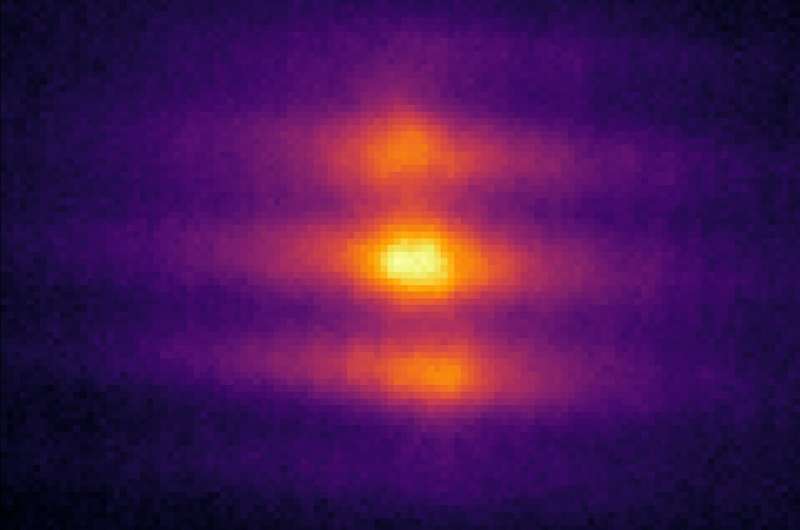Team's electric 'knob' tunes chemical reaction rates in quantum gas

Building on their newfound ability to induce molecules in ultracold gases to interact with each other over long distances, JILA researchers have used an electric "knob" to influence molecular collisions and dramatically raise or lower chemical reaction rates.
These super-chilly gases follow the seemingly counterintuitive rules of quantum mechanics, featuring exact units, or quanta, of energy and often-exotic motions. Thus, the ability to control chemical reactions in stable quantum gases could enable the design of novel chemicals and gases, new platforms for quantum computers using molecules as information-rich qubits (quantum bits), and new tools for precision measurement such as molecular clocks.
The advance is described in the Dec. 11 issue of Science. JILA is jointly operated by the National Institute of Standards and Technology (NIST) and the University of Colorado Boulder.
"The molecular collisions in our experiment are very quantum mechanical, with their trajectories all quantized in terms of the way in which they can approach each other," NIST/JILA Fellow Jun Ye said. "This is very different from a warm gas where molecules can approach each other randomly."
The new work follows up on Ye's many previous achievements with ultracold quantum gases . In particular, the advance builds on JILA's simplified scheme for nudging molecular gases down to their lowest energy state, called quantum degeneracy, in which the molecules start acting like overlapping waves that all interact.
The latest JILA experiments created a dense gas of tens of thousands of potassium-rubidium molecules within a six-electrode assembly, which researchers used to generate a tunable electric field. The molecules were confined in a stack of pancake-shaped laser traps called an optical lattice , but were free to collide within each pancake, like people skating on an ice rink, Ye said.
Collisions between molecules often result in chemical reactions that rapidly deplete the gas. However, the JILA team found that molecules could be "shielded" from these chemical reactions by turning a simple knob—the strength of the electric field. The shielding is due to the electric field modifying the rotations and interactions of the molecules.
The molecules repel each other because they are fermions, a class of particles that cannot be in the same quantum state and location at the same time. But the molecules can interact because they are polar, with a positive electric charge at the rubidium atom and a negative charge at the potassium atom. The opposing charges create electric dipole moments that are sensitive to electric fields. When the molecules collide head to tail, with opposing charges, chemical reactions rapidly deplete the gas. When the molecules collide side by side, they repel each other.
The JILA team started by preparing a gas in which each molecule was spinning with exactly one quantum unit of rotation. Thus, each molecule acted like a tiny quantum top, spinning around its axis, with only certain values of angular momentum (or speeds of rotation) allowed by quantum mechanics. By changing the electric field, the researchers found special fields ("resonances") where two colliding, spinning molecules could exchange their rotations, leaving one molecule spinning twice as fast and the other not spinning at all.
The ability to exchange rotations completely altered the nature of the collisions, causing the forces between colliding molecules to change rapidly from attractive to repulsive near the resonances. When the interactions between molecules were repulsive, the molecules were shielded from loss, since they rarely came close enough to chemically react. When the interactions were attractive, the chemical reaction rate was dramatically enhanced.
Near the resonances, the JILA team observed nearly a thousandfold change in the chemical reaction rate when tuning the electric field strength by just a few percent. With the strongest shielding, the chemical reaction rate was reduced to a tenth of the normal background value, creating a stable, long-lived gas.
This is the first demonstration of use of an electric field to resonantly control how molecules interact with each other. The experimental results agreed with theoretical predictions. JILA researchers expect their techniques to remain effective without the optical lattice, which will simplify future efforts to create molecular gases made of other types of atoms.
More information: "Resonant collisional shielding of reactive molecules using electric fields" Science (2020). science.sciencemag.org/cgi/doi … 1126/science.abe7370
Journal information: Science
Provided by National Institute of Standards and Technology





















